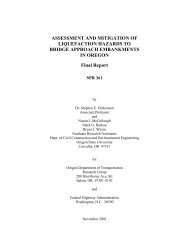Oregon Balance of State HIV/AIDS Housing & Services Systems ...
Oregon Balance of State HIV/AIDS Housing & Services Systems ...
Oregon Balance of State HIV/AIDS Housing & Services Systems ...
Create successful ePaper yourself
Turn your PDF publications into a flip-book with our unique Google optimized e-Paper software.
<strong>Oregon</strong> <strong>HIV</strong>/<strong>AIDS</strong> <strong>Housing</strong> and <strong>Services</strong> <strong>Systems</strong> Integration Plan 15<br />
Homelessness<br />
<strong>Oregon</strong> has one <strong>of</strong> the highest rates <strong>of</strong> homelessness per capita in the nation. <strong>Oregon</strong> <strong>Housing</strong> and<br />
Community <strong>Services</strong> (OHCS) reported that the number <strong>of</strong> <strong>Oregon</strong>ians who were homeless on any<br />
given night increased from 21 per 10,000 residents in 2002, to 31 per 10,000 in 2006. 40 A recent<br />
report estimated the 2007 homeless rate to be 45 per 10,000. 41 In 2006, the state <strong>of</strong> Washington<br />
estimated that 31 per 10,000 residents were homeless on any given night. 42<br />
The worsening statewide situation contrasts with the nationally recognized successes <strong>of</strong> the Portland<br />
10 Year Plan to End Homelessness, enacted in December 2004. During the first two years <strong>of</strong> the<br />
plan’s implementation, 1,039 chronically homeless individuals and 770 homeless families with<br />
children were housed, numbers far above the performance goals initially laid out in the plan. 43<br />
The 2007 <strong>Oregon</strong> one-night shelter count identified 13,020 total homeless people, including 4,655<br />
people who were turned away from shelters. These numbers are point-in-time counts <strong>of</strong> people who<br />
spent the night at a shelter or were turned away on one night in January 2007. One-night counts<br />
typically undercount homeless people in rural areas where shelter facilities are limited.<br />
Some counties in particular lack the facilities to serve homeless people seeking shelter. In 2007,<br />
Deschutes County reported 1,403 homeless people, including 1,179 who were turned away from<br />
shelters. The vast majority <strong>of</strong> those turned away were people in families with children. 44<br />
Most shelters and one-night counts do not keep data on the number <strong>of</strong> homeless people living with<br />
<strong>HIV</strong>/<strong>AIDS</strong>, although homeless people are known to have added risk <strong>of</strong> <strong>HIV</strong> diagnosis. The U.S.<br />
homeless population has an estimated median rate <strong>of</strong> <strong>HIV</strong> prevalence <strong>of</strong> at least three times<br />
higher—three percent versus one percent—than the general population. 45 The 2005 needs<br />
assessment for people living with <strong>HIV</strong>/<strong>AIDS</strong> in <strong>Oregon</strong> echoed the national findings on<br />
homelessness. Twenty-six percent <strong>of</strong> people living with <strong>HIV</strong>/<strong>AIDS</strong> reported being in unstable<br />
housing situations in the past year, and 15 percent had been homeless in the past two years. 46<br />
Homelessness is especially dangerous for people living with <strong>HIV</strong>/<strong>AIDS</strong>. Effective treatment <strong>of</strong><br />
<strong>HIV</strong>/<strong>AIDS</strong> requires a regular regimen <strong>of</strong> antiretroviral medications, which may be difficult to<br />
administer under conditions <strong>of</strong> homelessness or in emergency shelters. Many people living with<br />
<strong>HIV</strong>/<strong>AIDS</strong> may also be more susceptible to life-threatening infections if living on the street or in<br />
unsanitary conditions.<br />
40 <strong>Oregon</strong> Progress Board, Benchmarks Reports. Available online: http://benchmarks.oregon.gov (Accessed: October 15, 2007).<br />
41 Ending Homelessness Advisory Council (EHAC). Draft 10 Year Plan to End Homelessness, Part 1: Understanding Homelessness<br />
in <strong>Oregon</strong>. Available online: http://www.ehac.oregon.gov (Accessed: November 27, 2007).<br />
42 Washington <strong>State</strong> Department <strong>of</strong> Community, Trade and Economic Development <strong>Housing</strong> Division, 2006 Ten Year Plan to End<br />
Homelessness. Available online: http://cted.wa.gov/_CTED/documents/ID_3356_Publications.doc (Accessed: January 10, 2008).<br />
43 City <strong>of</strong> Portland, Bureau <strong>of</strong> <strong>Housing</strong> and Community Development. 2006 Annual Report for the 10 Year Plan to End<br />
Homelessness. Available online: http://www.portlandonline.com/bhcd/index.cfm?c=38062 (Accessed: November 29, 2007).<br />
44 Ending Homelessness Advisory Council (EHAC). Draft 10 Year Plan to End Homelessness, Part 1: Understanding Homelessness<br />
in <strong>Oregon</strong>. Available online: http://www.ehac.oregon.gov (Accessed: November 27, 2007).<br />
45 Higher rates (8.5 to 62 percent) have been found in selected homeless sub-populations. Song, John M.D., M.P.H., M.A.T.,<br />
<strong>HIV</strong>/<strong>AIDS</strong> & Homelessness: Recommendations for Clinical Practice and Public Policy, November 1999, National Health Care for<br />
the Homeless Council, Health Care for the Homeless Clinician’s Network, p. 1. Available online: www.nhchc.org (Accessed:<br />
January 10, 2002).<br />
46 <strong>Oregon</strong> Department <strong>of</strong> Human <strong>Services</strong>, Program Design and Evaluation <strong>Services</strong>. We Listened…2005: Survey for People Living<br />
with <strong>HIV</strong> and <strong>AIDS</strong> in <strong>Oregon</strong>. Available online: http://www.oregon.gov/DHS/ph/hiv/services/needs/reports.shtml (Accessed:<br />
November 27, 2007).

















